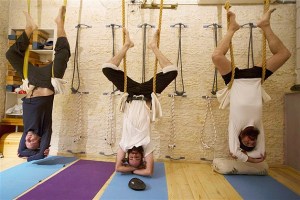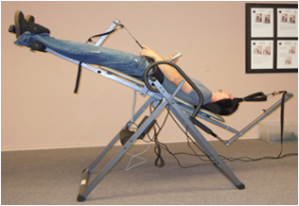 Inversion therapy involves a patient positioning himself upside down with gravity boots or an inversion table. The table method generally is considered safer and easier. The therapy is used to treat back pain, although preliminary research
Inversion therapy involves a patient positioning himself upside down with gravity boots or an inversion table. The table method generally is considered safer and easier. The therapy is used to treat back pain, although preliminary research![]() has provided conflicting results.
has provided conflicting results.
At the Back Pain Relief Center we use the Pettibon Spinal Rejuvenation table.
Designed for full spine traction and rejuvenation. Vibration is used to relax the muscles or red tissues and the adjustable traction angle can be set to up to 30º to help unlock the facet joints so that rehydration of the discs and ligaments or white tissues can begin. The dual traction of pulling both the neck and lower back decompress the entire spine. Patients control their level of tolerance for vibration, traction force and inversion angle.
Because mechanical traction is applied by an actuator along with gravity from the angle of inversion this makes this type of inversion traction safer as the patient is not required to be inverted nearly as much to get traction at the spinal joints. This is very helpful for those suffering from spinal degenerative joint disease and bulging spinal discs.
For those patients who are unable to tolerate inversion we also have a flat decompression table.
Potential side effects from other forms of inversion.
Eye Injuries
Gastrointestinal
If you have either a hiatal hernia, which occurs when a weakened diaphragm allows a portion of the stomach to move up into the chest cavity, or a ventral hernia, which develops at the site of previous surgeries, you should avoid inversion table therapy. It’s possible that the pressures from the upside-down orientation can make those conditions worse, one reason they are listed as contraindications by almost all manufacturers of inversion tables. There have also been anecdotal reports of nausea during inversion therapy.
Heart Effects
A study published in 1983 in the Journal of the American Osteopathic Association treated healthy volunteers from the Chicago College![]() of Osteopathic Medicine with three-minute periods of passive inversion. The volunteers experienced an increase in systemic blood pressure from 119/74 mm of mercury before inversion to 157/93 mm of mercury during inversion. For this reason, if you suffer from congestive heart failure, carotid artery stenosis, high blood pressure or other heart or circulatory disorders, or are on anticoagulants or aspirin therapy, inversion therapy is not recommended.
of Osteopathic Medicine with three-minute periods of passive inversion. The volunteers experienced an increase in systemic blood pressure from 119/74 mm of mercury before inversion to 157/93 mm of mercury during inversion. For this reason, if you suffer from congestive heart failure, carotid artery stenosis, high blood pressure or other heart or circulatory disorders, or are on anticoagulants or aspirin therapy, inversion therapy is not recommended.
Musculoskeletal Complaints
The Archives of Physical Medicine and Rehabilitation published a study in 1985 that documented several musculoskeletal side effects in human subjects undergoing inversion therapy. The most common were headaches, ankle discomfort, calf and thigh pain and chest discomfort. These symptoms were temporary, although a few, such as headaches, persisted for longer than five minutes.
Stroke
One of the most potentially serious side effects from inversion therapy is a stroke, which occurs when a blood vessel in the neck or brain becomes blocked or bursts. Due to the increased blood pressures involved in inversion therapy, as well as the pooling of blood into the neck and head areas, if you are already at risk for a stroke or transient ischemic attack, the inversion could trigger an attack. Symptoms typically include paralysis, difficulty speaking, memory loss and impaired thinking.
Read more: http://www.livestrong.com/article/157599-side-effects-of-inversion-tables/#ixzz2KwdIDbzn
